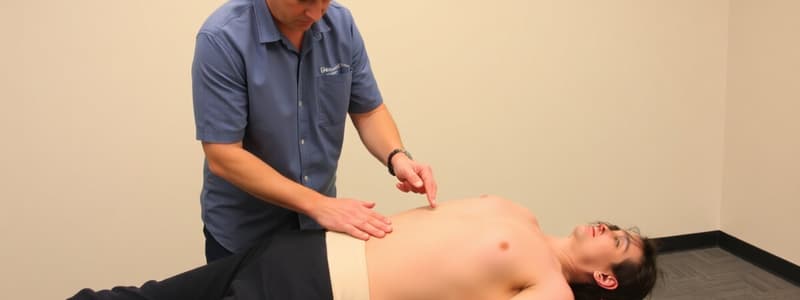Podcast
Questions and Answers
During the Craig's Test, what anatomical landmark is palpated to determine the degree of femoral anteversion?
During the Craig's Test, what anatomical landmark is palpated to determine the degree of femoral anteversion?
- The anterior superior iliac spine (ASIS)
- The greater trochanter (correct)
- The posterior superior iliac spine (PSIS)
- The lesser trochanter
A physical therapist performs the Hip Scour Test on a patient. What findings would indicate a positive test result suggestive of hip joint pathology?
A physical therapist performs the Hip Scour Test on a patient. What findings would indicate a positive test result suggestive of hip joint pathology?
- Increased range of motion compared to the contralateral hip.
- A smooth, fluid range of motion with no noted crepitus.
- Sharp, localized pain at the lateral hip during abduction.
- Reproduction of pain deep within the groin, along with bumpiness or crepitus during movement. (correct)
Which combination of movements is used during the FADIR test to assess for hip impingement or labral pathology?
Which combination of movements is used during the FADIR test to assess for hip impingement or labral pathology?
- Extension, Adduction, Internal Rotation
- Flexion, Adduction, Internal Rotation (correct)
- Flexion, Abduction, External Rotation
- Extension, Abduction, External Rotation
During the Modified Thomas Test, if a patient's test leg thigh remains above parallel to the table when the opposite knee is drawn to the chest, this indicates tightness in which muscle group?
During the Modified Thomas Test, if a patient's test leg thigh remains above parallel to the table when the opposite knee is drawn to the chest, this indicates tightness in which muscle group?
What does it indicate if, during the Modified Thomas Test, the test leg drifts laterally into abduction?
What does it indicate if, during the Modified Thomas Test, the test leg drifts laterally into abduction?
In the context of femoral anteversion assessment using Craig's Test, what range of femoral anteversion is typically considered normal?
In the context of femoral anteversion assessment using Craig's Test, what range of femoral anteversion is typically considered normal?
Ely's test is performed to assess the length of which muscle?
Ely's test is performed to assess the length of which muscle?
During the 90-90 Straight Leg Raising Test, what is considered a typical finding that indicates hamstring tightness?
During the 90-90 Straight Leg Raising Test, what is considered a typical finding that indicates hamstring tightness?
Which of the following conditions is Ober's Test primarily designed to assess?
Which of the following conditions is Ober's Test primarily designed to assess?
During Ober's test, what modification can isolate the TFL more effectively?
During Ober's test, what modification can isolate the TFL more effectively?
During the Faber test, what structures are being stressed when the test leg's knee remains above the opposite leg?
During the Faber test, what structures are being stressed when the test leg's knee remains above the opposite leg?
Which of the following pathologies is the FABER test designed to assess?
Which of the following pathologies is the FABER test designed to assess?
During Craig's test, an angle greater than 15° may indicate what condition?
During Craig's test, an angle greater than 15° may indicate what condition?
What is another name for the hip scour test?
What is another name for the hip scour test?
When the body is positioned prone when checking hamstring muscle length, what action increases trochanteric pain indicating bursitis?
When the body is positioned prone when checking hamstring muscle length, what action increases trochanteric pain indicating bursitis?
Based on the text, with a positive Ely's test, what action from the body indicates a Rec Fem length?
Based on the text, with a positive Ely's test, what action from the body indicates a Rec Fem length?
What position is the person performing Craig's test in?
What position is the person performing Craig's test in?
During CRAIG’S TEST what is the position of the knee?
During CRAIG’S TEST what is the position of the knee?
What does reproduction of pain during the FADIR test suggest?
What does reproduction of pain during the FADIR test suggest?
What sensation indicates Femoral nerve paresthesia during the ober's test?
What sensation indicates Femoral nerve paresthesia during the ober's test?
Flashcards
Craig's Test
Craig's Test
Estimates hip anteversion by palpating the greater trochanter during medial and lateral hip rotation.
Hip Scour Test
Hip Scour Test
Detects hip joint pathology by loading the hip joint and moving it through an arc of motion.
FADIR Test
FADIR Test
Assesses anterior-superior impingement (FAI) and labral pathology.
Modified Thomas Test
Modified Thomas Test
Signup and view all the flashcards
Ely's Test
Ely's Test
Signup and view all the flashcards
90-90 Straight Leg Raising Test
90-90 Straight Leg Raising Test
Signup and view all the flashcards
Ober's Test
Ober's Test
Signup and view all the flashcards
Faber Test
Faber Test
Signup and view all the flashcards
Study Notes
- Here are study notes from the provided text
Craig's Test
- Determines femoral anteversion by assessing the angle of the lower leg relative to vertical when the greater trochanter is parallel to the examining table.
- A positive finding is more than 15° angle, which may indicate excessive femoral anteversion but about 25° angle indicates it confidently.
- This test is also called Ryder's sign or Ryder's method.
- Common clinical finding is excessive medial rotation and decreased lateral rotation in the hip.
Hip Scour Test
- Evaluates hip joint pathology like changes in articular surfaces, undiagnosed OA, labral pathology, or soft tissue impingement.
- Recreation of pain deep in the groin area indicates a positive test.
- Other positive findings include bumpiness or crepitus during movement, early leathery end feel, or a block to movement.
- This test is also the flexion-adduction test, the quadrant test, or scouring test.
FADIR Test
- Assesses hip impingement, specifically femoroacetabular impingement (FAI), soft tissue impingement, and labral pathology.
- FADIR stands for Flexion, Adduction, and Internal Rotation.
- The test involves flexing the patient's hip and knee to 90 degrees each then applying passive internal rotation and adduction.
- If flexing the hip to 90° in neutral is difficult, that suggests likelihood of soft tissue or labral impingement.
Modified Thomas Test
- Determines the muscle length of hip flexors like iliopsoas, rectus femoris, and TFL.
- If the test leg thigh remains above parallel to the table, the iliopsoas is short.
- If the test leg tibia remains straighter than 80° to the femur, the rectus femoris is short.
- If the test leg drifts laterally into ABD, the TFL is short.
Ely's Test
- Evaluates the length of the rectus femoris muscle.
- The hip on the same side spontaneously flexes, and the ASIS comes off table when flexing.
90-90 Straight Leg Raising Test
- Assesses hamstring muscle length.
- Involves flexing both hips to 90 degrees while the knees are bent, then actively extending each knee in turn as much as possible.
- The knee should be extended > 20° short of full and angle is below 70 degrees.
Ober's Test
- Assesses TFL & ITB contracture.
- The test leg remains above neutral (ABD position) and cannot fall into an ADD position.
- To perform, take the test leg (upper leg) and passively abduct and extend with the knee straight while the hip remains in slight extension, then gently remove support from the leg allowing it to fall into an adducted position toward the table.
- If you flex the knee, you remove tension from IT band to test more TFL.
- Other findings include trochanteric pain (bursitis) or femoral nerve paresthesia (especially if the knee is also flexed).
- Knee Flexed tests more TFL
- Knee Extended tests more ITB
Faber Test
- Assesses hip joint pathology, FAI, psoas pathology or impingement, anterior capsular involvement, or SI joint involvement.
- Stands for FLX, ABD, ER.
- Recreation of Pain occurs
- Test leg's knee remains above the opposite leg indicates a positive test.
- To perform, place foot of test leg on top of opposite knee and slowly lower knee of test leg.
Studying That Suits You
Use AI to generate personalized quizzes and flashcards to suit your learning preferences.




